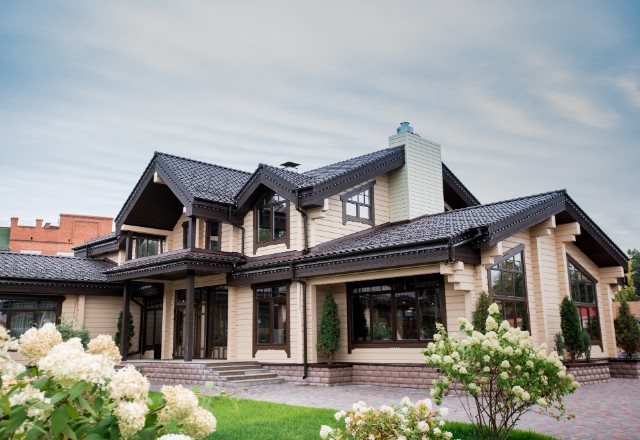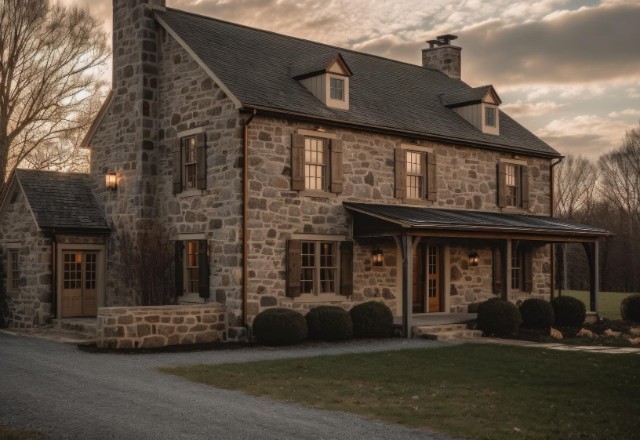Siding is an essential component of any building’s exterior. The primary function of siding is to protect the structure from weather and other environmental conditions while also enhancing its aesthetic appeal. Siding is commonly made from a range of materials such as wood, vinyl, fiber cement, stucco, metal, and stone. This diversity of materials allows homeowners and contractors to select a siding option that suits their needs, preferences, and budget. Apart from its benefits as a weather barrier, siding also adds insulation to the building, reducing energy consumption and saving on heating and cooling bills. In the following sections, we will explore the various siding replacement options and highlight some of the best materials for the job.
Disclaimer: The information provided in this article is for informational purposes only and should not be used as a substitute for professional advice from qualified contractors. We recommend that you consult a professional contractor or specialist to ensure that the siding replacement options offered here are suitable for your particular home. Advance Roofing LLC has been providing exceptional roofing solutions to clients in Spokane, WA for many years and always stands ready to assist with any questions or concerns you may have concerning siding replacement.
Benefits of Replacing Old Siding
Replacing old siding can have a significant impact on a home’s aesthetic appearance, energy efficiency, and overall value. Outdated or damaged siding not only detracts from a home’s curb appeal but can also cause increased energy costs due to poor insulation. Additionally, outdated siding can lead to costly repairs down the line if not addressed promptly.
Opting for new siding can improve a home’s curb appeal and provide better insulation, resulting in lower energy bills. The use of materials such as wood, vinyl, and fiber-cement offer a variety of styles and colors to choose from, allowing a homeowner to transform the look of their home. These materials are also known for being easy to maintain, durable, and long-lasting, ultimately increasing a home’s value.
Types of Siding Available
When it comes to replacing the siding of a home, homeowners have a range of choices to consider. Each type of siding material offers its own unique set of advantages and disadvantages, which can make it challenging to choose the right one. To help with this decision, it is important to review the different types of siding materials available and their features. By taking the time to compare the options, homeowners can make an informed choice that matches their preferences, budget, and the needs of their home. Below are some of the most popular types of siding available on the market today.
Aluminum Siding
Aluminum siding is an affordable option for homeowners who want a low-maintenance exterior siding. It is resistant to rust and corrosion, making it a durable and long-lasting choice. Another advantage of aluminum siding is its insulation properties, which can reduce energy costs and keep homes cooler in the summer and warmer in the winter.
Aluminum siding is prone to denting and can produce more noise during heavy rain or hail. Appropriate insulation during installation can decrease noise levels and denting. The price of installing aluminum siding fluctuates based on location, but the average cost is between $3 to $6 per square foot.
Vinyl Siding

Vinyl siding is a popular choice among homeowners due to its affordability and ease of installation. This type of siding is weather-resistant and can withstand extreme temperatures, making it durable against harsh weather conditions. Additionally, vinyl siding comes in a wide range of colors and styles, giving homeowners more options to choose from when renovating their house’s exterior.
The sustainability of vinyl siding is a concern for some homeowners. While the production process of vinyl siding has improved over the years, it is still not a completely sustainable option. The material used in vinyl siding cannot be recycled, which can have a negative impact on the environment.
However, vinyl siding’s durability can offset some of its sustainability concerns. Proper installation and maintenance can help prolong its lifespan, reducing the need for frequent replacements.
Wood Siding

Wood siding is a classic and popular option for homeowners who crave a natural and rustic look for their exteriors. However, it is one of the most expensive and high maintenance siding choices on the market.
One of the key benefits of wood siding is its timeless aesthetic appeal. It comes in a wide variety of styles such as cedar shingles, wood shingles, and lap siding. This versatility makes it a popular choice for homeowners who want to create a warm and inviting look for their homes.
However, wood siding is also prone to warping, rotting, and fading over time due to exposure to the elements. This requires frequent maintenance to keep up a fresh appearance. Regular upkeep includes repainting or restaining every few years and sealing any cracks or gaps to prevent moisture from seeping in.
Wood siding’s high-maintenance aspect can be a drawback for homeowners who want a low-maintenance exterior for their homes, which makes it one of the most expensive siding choices on the market. It also requires professional installation to ensure it is done correctly.
Fiber-Cement Siding (James Hardie)
Fiber-cement siding, specifically James Hardie, is a popular option for homeowners who want the appearance of traditional shiplap wood siding but with greater durability. It is made from a mixture of cement, sand, and cellulose fibers that are pressed into thin sheets. These sheets are then cut into desired lengths and shapes and baked in high temperature ovens to create a durable material that can withstand extreme weather conditions.
James Hardie, one of the leading brands in the fiber-cement siding industry, offers a closely mimicked appearance to traditional wood siding while providing the added benefits of being resistant to rot, insects, and fire. Its thickness ranges from 5/16 inch to 1 inch, depending on the desired level of insulation and durability.
While fiber-cement siding has a higher up-front cost than some other siding materials, its durability means it requires minimal maintenance, making it a cost-effective long-term investment for homeowners. Professional installation is recommended, but the end result is a beautiful and durable exterior that can last for decades.
Steel Siding
Steel siding is a popular choice for homeowners due to its cost-effectiveness, durability, and low maintenance requirements. This type of siding is known for its ability to withstand extreme weather conditions and is naturally resistant to pests and insects. Additionally, steel siding requires very little maintenance over its lifetime.
While steel siding provides several benefits, it is not without its drawbacks. One of the major cons of steel siding is the potential for rusting, which can occur if the steel is not properly protected. Additionally, steel siding does not provide insulation, which can lead to higher heating and cooling costs for homeowners.
Stucco Siding
Stucco siding has been a popular choice for many homeowners due to its durability and unique aesthetic qualities. It is made from a mixture of sand, cement, and water, which results in a textured, earthy look that can complement a variety of architectural styles. One of the biggest benefits of stucco siding is its low maintenance requirements. It is resistant to mold, mildew, and pests, and can last for several decades with proper care.
However, stucco siding is also susceptible to moisture damage and structural shifts. It requires a weather-resistant barrier to prevent moisture from seeping into the walls, and proper installation is crucial to avoid cracks and other forms of damage. Stucco installation can also be relatively expensive, with costs ranging from $6 to $9 per square foot.
Ideal conditions for stucco siding include warm, dry climates where precipitation and humidity are not as prevalent. It can also be a good option for homeowners looking to enhance their energy efficiency, as stucco can provide a layer of insulation that can help keep heating and cooling costs low.
Overall, stucco siding can be a great choice for homeowners looking for a low maintenance, energy-efficient siding material with unique aesthetic qualities. However, it may not be the best option for areas with high rainfall or humidity, and proper installation is key to avoid structural issues in the long term.
Stone Veneer & Natural Stone

Stone veneer and natural stone are both excellent options for siding, providing durability and an attractive aesthetic.
Stone veneer is a lighter and more affordable option, which often comes as manufactured panels that imitate the appearance of natural stone. The cost of stone
veneer varies based on the type of stone and the brand, but it’s generally more affordable than natural stone options. Stone veneer is also known for its ease of installation, and it’s often applied directly over an existing wall, reducing the need for additional framing. Popular products include ADORN Colorado Gray Stone Veneer Siding, which has a classic, elegant look.
On the other hand, natural stone siding provides an authentic and timeless look that can add value to any home. The cost of natural stone siding is typically higher than stone veneer, and it requires professional installation to ensure that it’s done correctly. Natural stone options are also heavier, which means that additional structural support may be necessary during installation. However, natural stone is incredibly durable and weather resistant, making it an excellent investment in the long term. Popular natural stone options include granite, limestone, and sandstone.
Factors to Consider When Choosing a New Type of Siding
Choosing a new type of siding for your home is an important decision that can impact the appearance, maintenance, and durability of your property. With a wide range of siding materials and styles available on the market, it can be challenging to decide which one is the best option for your needs. To help you make the right choice, there are several factors to consider when selecting a new type of siding. These include your budget, climate conditions, maintenance requirements, and desired aesthetic appeal. By taking these factors into account, you can find the perfect siding solution that enhances the curb appeal of your home and provides long-term value and protection.
Variety of Colors and Styles Available

When it comes to choosing the right siding replacement, there are many factors to consider, including the materials used and the available color and style options.
Vinyl siding is known for having the most variety in terms of color options, thanks to the advancements in manufacturing technology. Nowadays, vinyl siding is available in almost any color imaginable, ranging from traditional shades of beige and grey to brighter ones like red and green. Moreover, custom color options are also available, which means homeowners can truly personalize the look of their homes.
Other siding choices, such as fiber cement, natural wood, and brick veneer, also offer a wide range of colors and styles. Fiber cement siding and brick veneer siding can mimic the appearance of natural stone, wood, or stucco, while engineered wood siding offers a more natural wood look.
To ensure that you choose the best color and style options for your home, it’s recommended to consult with a local contractor. They can help guide you in selecting the right options that take into consideration your home’s architecture, weather conditions, and personal preferences. With a variety of styles to choose from, siding can significantly enhance your home’s curb appeal.
Durability and Maintenance Requirements
When it comes to durability, brick and stone veneer are the clear winners. These materials can last for decades and are extremely resistant to nature’s elements. They are fire resistant and virtually maintenance-free, making them an ideal choice for homeowners who want a long-lasting, hassle-free alternative to other types of siding.
Fiber cement siding is also a highly durable option. It is strong, fire-resistant, and resistant to nature’s elements. It also requires little maintenance, but it does need to be painted or re-stained every few years to maintain its appearance.
Stucco is less durable than brick, stone, or fiber cement siding. It can be prone to cracks and damage over time due to weather conditions and shifts in the foundation of the home. Additionally, stucco requires regular maintenance to prevent water damage and maintain its appearance.
In terms of maintenance requirements, vinyl siding requires the least amount of upkeep. It does not need to be painted or stained and can easily be cleaned with a hose or pressure washer. However, vinyl siding is not as durable as some of the other options and can be prone to damage from extreme weather conditions.
Labor Costs for Installation

Labor costs for installing siding materials can vary depending on several factors. The average cost per square foot for installation ranges from $3 to $10, with some of the more expensive options like real stone or brick veneer costing upwards of $15 per square foot.
When it comes to wood siding, cedar shingles are the most expensive option, with an average cost of $6 to $10 per square foot for installation. Plywood is the most affordable option, with an average cost of $1.50 to $3 per square foot for installation.
Labor costs may also vary depending on the size and complexity of a home. A larger home will require more materials and labor to install, which will increase the overall cost. Additionally, if a home has unique or intricate architecture, it may require more time and effort to properly install the siding, which will also increase the labor costs.
It is important to factor in labor costs when choosing a siding material, as it can significantly impact the overall cost of the project. Homeowners should do their research to determine which option will meet their budget and aesthetic preferences.
Price Point Comparison Between Types of Materials

When it comes to siding replacement, price is an important consideration for homeowners. Here’s a comparison of the price points for different siding materials:
- Vinyl siding is the most popular and affordable option, with an average cost of $2 to $7 per square foot for installation. It requires little maintenance and comes in a wide range of colors and styles. However, it is not as durable as other materials and may crack or fade over time.
- Fiber cement siding is a durable and low-maintenance option, with an average cost of $5 to $12 per square foot for installation. It is resistant to fire, insects, and rot. However, it is heavier and harder to install, which can increase labor costs.
- Wood siding is a natural and aesthetically pleasing option, with an average cost of $6 to $12 per square foot for installation. Cedar shingles are the most expensive, while plywood is the most affordable. However, wood siding requires regular maintenance to prevent rot and insect damage.
- Brick and stone veneer siding are both durable and low-maintenance options, with an average cost of $7 to $20 per square foot for installation. They provide a high-end look but are more expensive and require skilled labor to install.
Overall, the cost of siding replacement varies depending on the material, installation, and maintenance requirements. Homeowners should weigh the pros and cons of each option to choose the best siding material that suits their budget and aesthetic preferences.
Conclusion
In conclusion, choosing the right siding for your home is an important investment that can increase your home’s value and provide a valuable safety feature. Different materials offer varying degrees of durability and cost differences. Vinyl siding is a popular choice due to its affordability and wide range of options, while fiber cement siding offers greater durability and low maintenance. Wood siding provides a natural and aesthetically pleasing option, but requires more maintenance to prevent damage. Brick and stone veneer siding provide a high-end look but are more expensive and require skilled labor to install. Regardless of the material you choose, siding is an effective tool for beautifying your home and protecting it from the elements. Whether you’re looking to increase curb appeal or invest in the long-term durability of your home, choosing the right siding is a crucial decision.



 509-201-4190
509-201-4190
